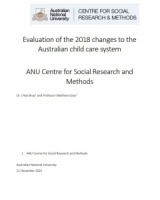Evaluation of the 2018 changes to the Australian child care system

Abstract
In 2018 the Australian Government introduced a new funding model for the support of child care provision in Australia. These changes were promoted as being ‘once in a generation’ reforms. Key objectives were to improve affordability and increase workforce participation. A consortium of researchers was commissioned by the government to undertake an evaluation of these changes. The evaluation found that the measures introduced had improved affordability for just over 60 per cent of families. In line with the policy intent, low and middle income earners were more likely to be beneficiaries, while higher income families tended to incur higher costs. The evaluation found however that these impacts were generally modest and there was no evidence that the policy had addressed the historical trends of an increasing real cost of care. While reducing the potential costs of additional employment for families needing care, these remain high. The policy had diverse labour market impacts, with evidence of some increase in participation, but the magnitude of this was not inconsistent with longer-term trends. There was little if any impact on access or on the flexibility of care options, although there was evidence of services varying session lengths to maximise the subsidy parents could receive. The evaluation concluded that in addition to these modest impacts with regard to these policy objectives, the package did not address the wider set of key policy questions about the role of early childhood education and care.








